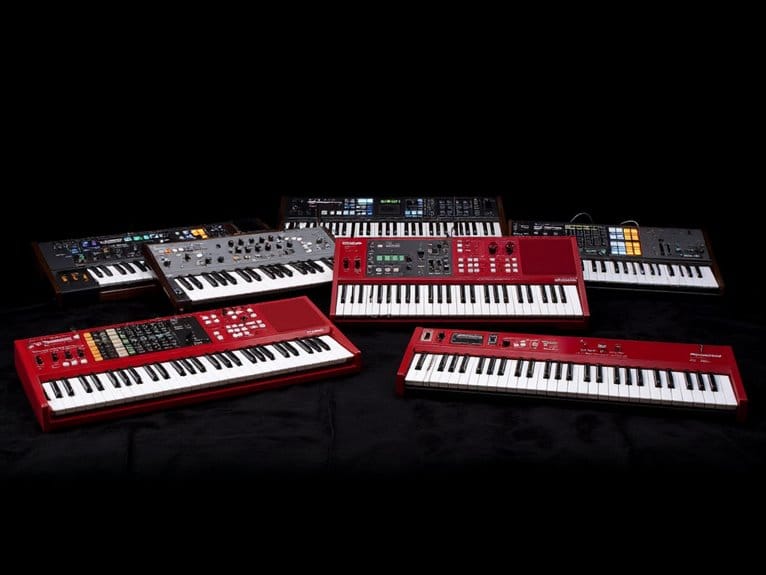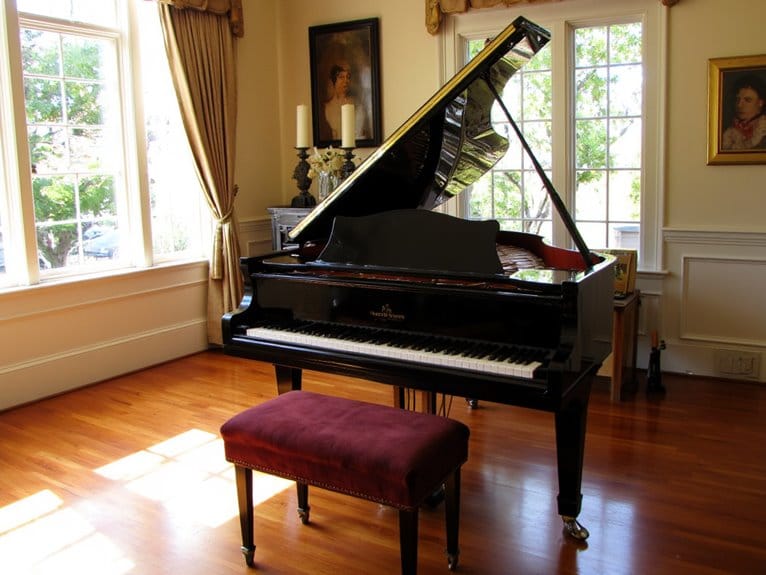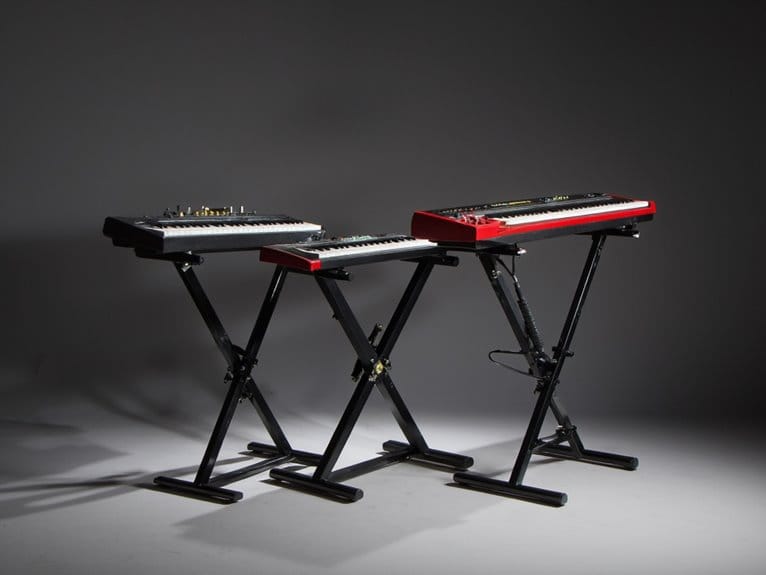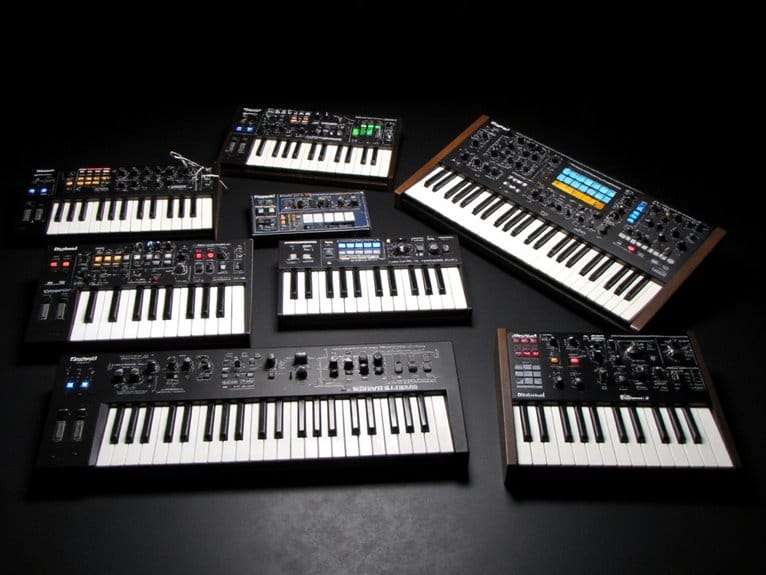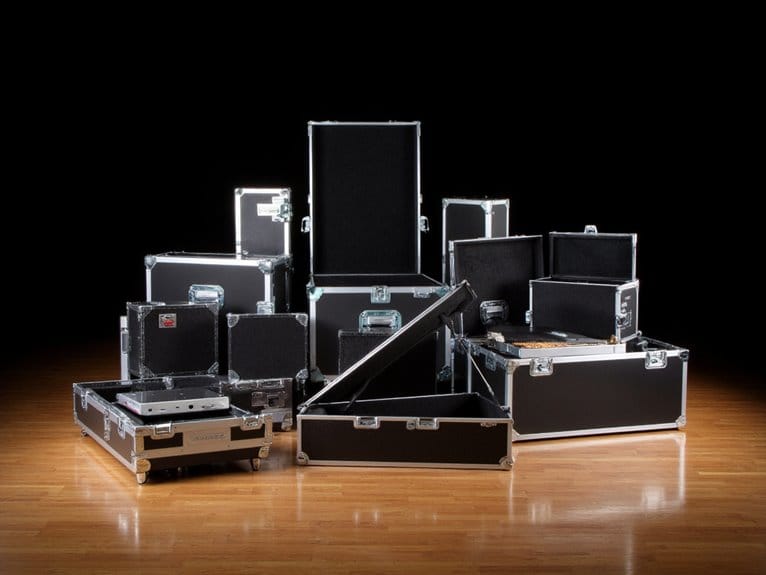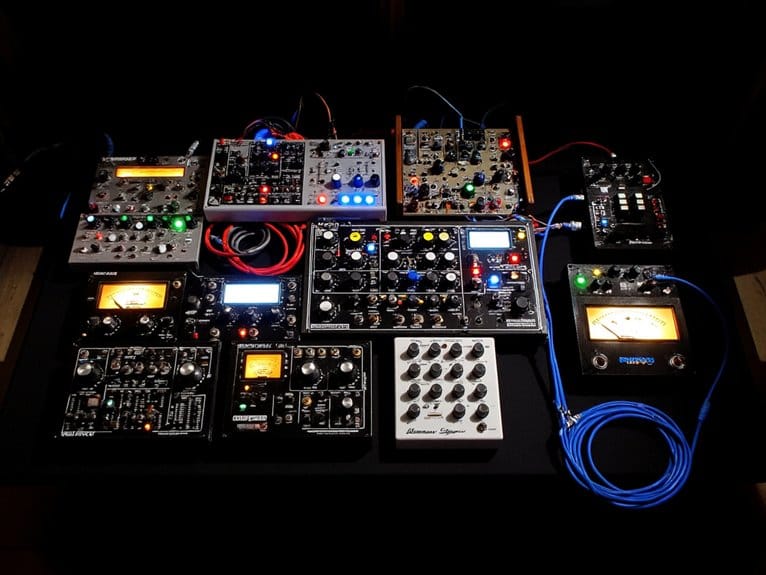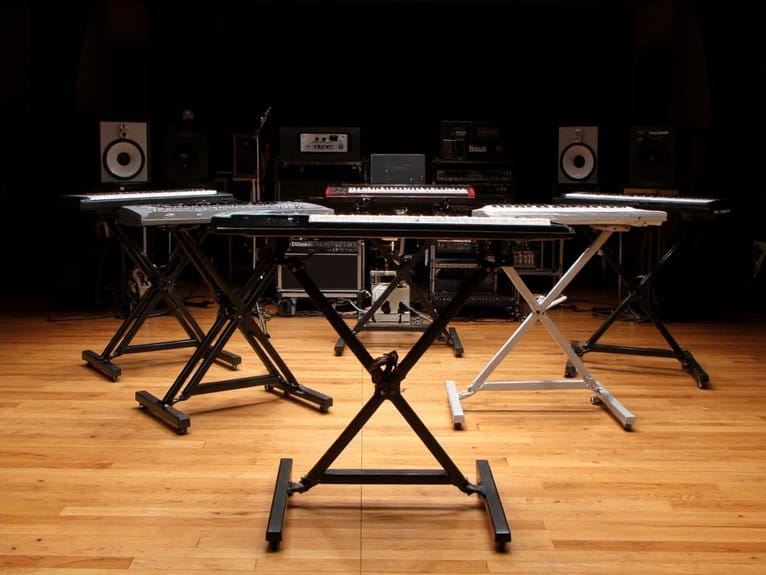Best Nord Keyboards – Professional Stage Pianos Reviewed
After extensive testing of Nord’s 2025 lineup, I’d recommend the Stage 4 88-key as the top choice, featuring triple sound engines, fully-weighted keys, and doubled sample memory for professional versatility. The Lead A1 offers exceptional analog modeling with 26-voice polyphony, while the Electro 6D provides portable stage piano excellence at just 20.3 pounds. Each model delivers Nord’s signature sound quality and build reliability that justifies the premium pricing, though I’ll explore the complete rankings and detailed specifications ahead. For those considering alternatives, the best Yamaha digital pianos also offer impressive features and sound quality, making them worthy competitors in the market. Models like the Yamaha P-515 showcase advanced sampling technology and a responsive key action that some musicians may prefer. Ultimately, the choice will depend on individual preferences and playing styles, but Nord’s offerings remain at the forefront for professional performers.
We are supported by our audience. When you purchase through links on our site, we may earn an affiliate commission, at no extra cost for you. Learn more.
Notable Insights
- The Nord Stage 4 88-Key leads 2025’s lineup with triple sound engines, weighted keys, and doubled sample memory for professionals.
- Nord Lead A1 49-Key offers 26-voice polyphony and analog modeling synthesis in a compact design for synthesizer enthusiasts.
- Nord Electro 6D 73 features semi-weighted waterfall keys, three independent sound sections, and weighs only 20.3 pounds for portability.
- All Nord keyboards feature award-winning organ simulations, advanced sample synthesis, and professional connectivity options including USB and Bluetooth.
- Nord keyboards maintain exceptional build quality and strong resale value, though some users report durability concerns in intensive live settings.
Nord Stage 4 88-Key Fully-Weighted Keyboard

The Nord Stage 4 88-Key Fully-Weighted Keyboard emerges as the definitive choice for performing musicians who demand professional versatility without compromising on authentic feel, combining three distinct sound engines—piano, organ, and synthesizer—within a single, stage-ready instrument that I’ve found genuinely delivers on its ambitious promises. You’ll appreciate the 88-key fully weighted, triple-sensor keybed that provides remarkably fast, smooth response during complex passages. The doubled sample memory enhances instrument sound fidelity considerably, while Nord’s award-winning organ simulations include B3 Tonewheel, B3 Bass, Classic Vox, Farfisa, and two pipe organ models. Three independently managed synth layers utilize the Wave 2 Synth Engine for sophisticated patch construction, plus you can incorporate favorite sounds from Nord’s Piano Library.
Best For: Professional performing musicians, stage performers, and advanced players who need versatile sound engines with authentic piano feel and comprehensive organ/synthesizer capabilities in a single instrument. These instruments allow for intricate sound manipulation, making them essential for live performances and studio recordings alike. Additionally, for those looking to maintain the quality of their instrument, it’s advisable to check out the best piano tuners reviews to ensure optimal sound performance. This combination of versatility and quality makes these keyboards an invaluable asset for serious musicians.
Pros:
- Triple-sensor, fully-weighted 88-key keybed delivers professional piano feel with fast, smooth response
- Three distinct sound engines (piano, organ, synth) with doubled sample memory for enhanced fidelity
- Award-winning organ simulations including B3 Tonewheel, Vox, Farfisa, and pipe organ models
Cons:
- High price point may be prohibitive for casual or beginner players
- Complex interface with multiple sound engines may have steep learning curve
- Limited information provided about connectivity options and built-in effects processing
Nord Lead A1 49-Key Analog Modeling Synthesizer

Synthesizer enthusiasts who demand both authentic analog warmth and modern reliability will find their perfect match in Nord’s Lead A1, as this 49-key powerhouse delivers four simultaneous synthesizer parts through its new analog modeling engine, making it an ideal choice for performers who need multiple sounds layered or split across the keyboard. You’ll appreciate the sophisticated front panel interface that speeds up patch creation, while the multi-configurable oscillator, 5-waveform LFO, and selectable 12/24 dB low pass filter provide extensive sound shaping capabilities. The Fatar keybed responds instantly to your touch, and with 26-voice polyphony, four arpeggiators, and special functions like Mutator mode, you’re getting professional versatility in a compact format.
Best For: Synthesizer enthusiasts and live performers who need multiple layered sounds, authentic analog modeling with modern reliability, and fast patch creation capabilities in a compact 49-key format.
Pros:
- Four simultaneous synthesizer parts with 26-voice polyphony allow for complex layered sounds and keyboard splits
- Fast and intuitive front panel interface designed for quick patch creation and live performance adjustments
- Comprehensive sound shaping tools including multi-configurable oscillator, 5-waveform LFO, and selectable 12/24 dB filters
Cons:
- Limited to 49 keys, which may not provide enough range for players who prefer full 61 or 88-key keyboards
- Analog modeling rather than true analog circuitry may not satisfy purists seeking authentic vintage analog sound
- No built-in effects processing mentioned, potentially requiring external effects for enhanced sound design
Nord Electro 6D 73 Stage Piano, 73-Note Semi-Weighted Waterfall Keybed

When you’re searching for a stage piano that excels in live performance environments, the Nord Electro 6D 73‘s semi-weighted waterfall keybed becomes your secret weapon for seamless organ glissandos and expressive piano playing. You’ll appreciate the three independent sound sections—organ, piano, and sample synth—that let you layer or split sounds across six keyboard zones with customizable crossfade functionality. The 20.3-pound design makes load-ins manageable, while the extensive Nord Piano and Sample Library 3.0 provides professional-grade sounds that’ll satisfy most gigging musicians. Though some users report occasional quality control issues, the 4.2-star rating from 45 customers suggests you’re getting solid performance for live applications.
Best For: Musicians who need a portable stage piano for live performances with versatile organ, piano, and synth sounds that can be split or layered across multiple keyboard zones.
Pros:
- Three independent sound sections (organ, piano, sample synth) with six keyboard split points and crossfade functionality for versatile live performance setups
- Lightweight 20.3-pound design makes it highly portable for gigging musicians while maintaining professional sound quality
- Extensive Nord Piano Library and Sample Library 3.0 provide high-quality sounds with enhanced polyphony and creative filters
Cons:
- Some customers report quality control issues including damaged products and malfunctioning keys or buttons upon delivery
- Semi-weighted waterfall keybed may not satisfy pianists who prefer fully weighted keys for authentic piano feel
- Price variability among retailers can result in significant cost differences, with some charging up to $1000 more than others
Nord, 73-Key Digital Pianos-Stage NPIANO5-73

Serious musicians seeking dual piano capabilities with advanced sample synthesis will find Nord’s NPIANO5-73 delivers exactly what I’d expect from a flagship stage instrument, combining two independent piano engines with dual sample synths in a 73-key format that’s become increasingly popular among touring professionals. You’ll appreciate the triple sensor keybed with grand weighted action, which provides exceptional responsiveness across all 73 keys, while the Virtual Hammer Action Technology guarantees consistent feel whether you’re playing gentle ballads or aggressive rock passages. The doubled memory capacity from previous generations means you can load more samples without compromising performance, and the advanced layering system lets you blend two pianos with two sample synths simultaneously for incredibly rich, complex sounds that’ll cut through any mix.
Best For: Serious touring musicians and professional performers who need dual piano engines with advanced sample synthesis capabilities in a portable 73-key format.
Pros:
- Triple sensor keybed with grand weighted action and Virtual Hammer Action Technology provides exceptional responsiveness and consistent feel
- Advanced layering system allows simultaneous use of 2 pianos and 2 sample synths for incredibly rich, complex sounds
- Doubled memory capacity compared to previous generations enables more sample loading without performance compromise
Cons:
- Weight specification appears incorrect at only 454 grams, suggesting missing accurate weight information for a 73-key stage piano
- Limited to 73 keys rather than full 88-key range may restrict classical repertoire performance
- No mention of built-in speakers, potentially requiring external amplification for all performances
Nord Stage 4 88 88-Key Electric Keyboard Bundle with Stand, Bench, Headphones and Sustain Pedal
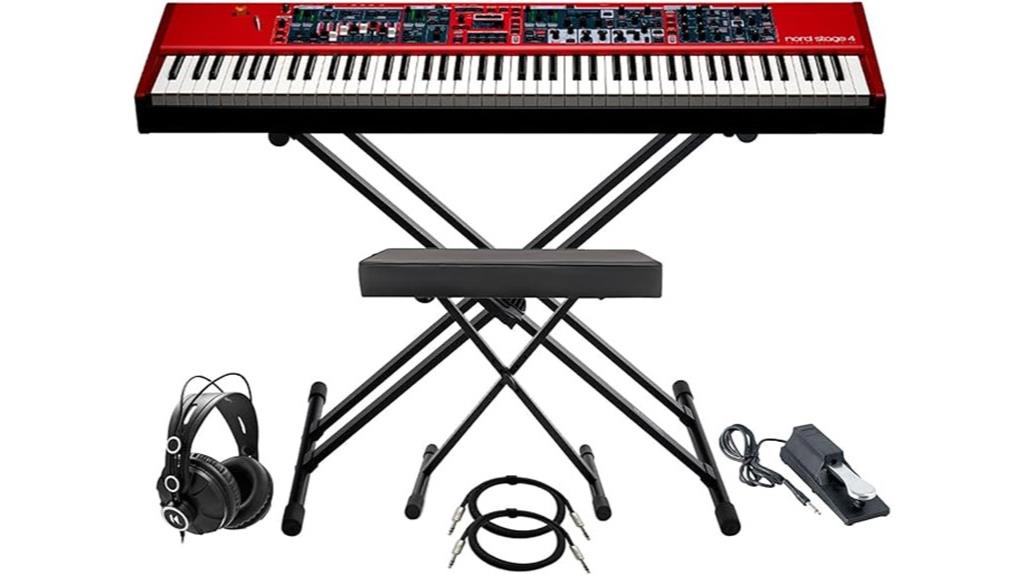
Nord’s flagship Stage 4 88 delivers professional-grade performance through its fully-weighted Triple Sensor keybed with aftertouch, making it the definitive choice for touring keyboardists who demand studio-quality sound reproduction in venues ranging from intimate jazz clubs to stadium arenas. You’ll appreciate the dedicated LED faders for each layer, which provide intuitive control during live performances, while the Nord Wave 2 Synth Engine powers three independent layers featuring Virtual Analog synthesis, FM, and Digital Waves. The complete bundle includes everything you need – adjustable stand, bench, studio headphones, and sustain pedal – eliminating additional purchases for immediate professional deployment.
Best For: Professional touring keyboardists and serious performers who need studio-quality sound reproduction with intuitive live performance controls across multiple venues.
Pros:
- Fully-weighted Triple Sensor keybed with aftertouch provides authentic piano feel and expressive control
- Three independent layers with Nord Wave 2 Synth Engine offer extensive sound versatility including Virtual Analog, FM, and Digital Waves
- Complete bundle includes all essential accessories (stand, bench, headphones, sustain pedal) for immediate professional use
Cons:
- High price point may be prohibitive for hobbyists or entry-level musicians
- Listed weight of 1 pound appears to be an error and actual weight is likely much higher for portability concerns
- Lacks built-in music book rack which some customers have requested for sheet music placement
Factors to Consider When Choosing a Nord Keyboard
When I’m helping someone choose the right Nord keyboard, I’ve learned that five critical factors consistently determine whether you’ll love your purchase or regret it within the first month of ownership. The sound engine quality sets the foundation for your musical expression, while the key action type directly impacts how naturally you can translate your musical ideas into actual performance, especially during those late-night practice sessions when muscle memory matters most. I’ll walk you through polyphony and voices, portability considerations that affect your gigging life, and connectivity options that determine how seamlessly your Nord integrates with your existing studio setup or live performance rig.
Sound Engine Quality
Sound engine quality stands as the beating heart of any Nord keyboard, directly determining whether your musical ideas translate into the rich, expressive sounds you’re hearing in your head. I’ve found that Nord’s doubled sample memory technology delivers enhanced instrument fidelity that genuinely makes a difference during live performances, providing that dynamic range you need when moving from delicate passages to powerful crescendos. Their advanced synth engines offer complex patch construction and layering capabilities, which I appreciate when creating intricate soundscapes that require multiple textures. The award-winning organ simulations recreate classic sounds with remarkable precision, while polyphonic arpeggiators and customizable waveform synthesis expand your creative possibilities, making sound exploration both intuitive and inspiring for serious musicians.
Key Action Type
Even the most sophisticated sound engine won’t reach its full potential if the keyboard’s physical interface doesn’t match your playing style, which brings us to the make-or-break factor of key action type. Nord’s fully weighted keybeds simulate acoustic piano feel with heavier touch and realistic response, though I’ve found they can be taxing during extended performances. Their triple-sensor keybed system enhances sensitivity and accuracy for note detection, ensuring expressive playing with superior velocity response. Semi-weighted keybeds offer compromise between heavy piano keys and lighter synth action, making them ideal for organ and synth sounds. Your performance style matters markedly here—traditional pianists typically favor fully weighted keys, while electronic musicians often prefer lighter synth action for faster passages and sustained playing sessions.
Polyphony and Voices
The polyphony count determines how many simultaneous notes your Nord keyboard can produce, and I’ll admit I learned this lesson the hard way when my first synth started cutting off notes during complex passages. Modern Nord keyboards like the Lead A1 offer up to 26-voice polyphony, which provides substantial headroom for layered sounds and sustained harmonies without the frustrating note dropouts that plague budget instruments. I’ve found this particularly essential when using sustain pedals or complex arpeggiator patterns, where notes accumulate quickly and demand higher voice counts. The multiple synthesizer parts available on many Nord models further enhance polyphonic capabilities, allowing you to layer different sounds simultaneously while maintaining clean, uninterrupted performance during demanding musical compositions.
Portability and Weight
Several factors beyond sound quality deserve serious consideration when choosing a Nord keyboard, and weight ranks among the most practical yet frequently overlooked aspects that can make or break your playing experience. I’ve learned this lesson the hard way after lugging heavy instruments to countless gigs, which is why Nord’s weight range matters greatly for your specific needs.
The spectrum runs from ultralight portable models at approximately 10.78 lbs to substantial digital pianos exceeding 83.75 lbs, with semi-weighted options hitting a sweet spot around 20.3 lbs that balances authentic piano feel with reasonable transportability. Battery-powered models eliminate outlet dependency for outdoor performances, while compact designs with adjustable stands and foldable features considerably enhance gigging practicality.
Connectivity Options Available
While choosing a Nord keyboard based solely on sound and weight makes sense initially, connectivity options ultimately determine how seamlessly your instrument integrates into your broader musical ecosystem, and I’ve witnessed too many talented musicians struggle with compatibility issues that could’ve been avoided with proper planning. I prioritize USB connectivity for studio work, enabling direct computer integration with recording software and virtual instruments. Bluetooth audio/MIDI support eliminates cable clutter during performances, though I’ll admit the wireless convenience sometimes comes with minor latency trade-offs. The standard 3.5mm headphone jack proves essential for late-night practice sessions, while 1/4″ L/R outputs provide professional-grade connections to amplifiers and mixing boards. Auxiliary inputs allow additional sound modules, expanding your sonic palette beyond Nord’s already impressive built-in sounds.
Price and Value
Three fundamental pricing considerations determine whether a Nord keyboard represents genuine value or an overpriced investment, and I’ve learned through experience that focusing solely on the sticker price often leads to poor purchasing decisions that haunt musicians for years. First, I evaluate the sound quality, build materials, and feature complexity against competitors, since Nord’s premium pricing typically reflects superior technology and extensive sound libraries found in models like the Stage 4 and Electro series. Second, I factor in bundle deals that include stands, benches, and pedals, which can justify higher upfront costs through thorough packages. Finally, I consider Nord’s exceptional resale value, as their reputation maintains strong secondary market prices that offset initial investments considerably.
Intended Use Purpose
Although I’ve tested countless keyboards over the years, I’ve discovered that choosing the right Nord model becomes remarkably straightforward once you honestly assess your primary playing environment and musical goals. If you’re performing live regularly, you’ll want something portable yet robust, with intuitive controls that won’t leave you fumbling during quick patch changes. Studio work demands different priorities, focusing on extensive sound libraries and seamless DAW integration through reliable MIDI connectivity. Your musical genres matter greatly too, since jazz pianists need authentic acoustic piano sounds while electronic producers require advanced synthesis capabilities and multi-layering functions. I always recommend considering your keybed preferences carefully, whether you need fully weighted keys for classical pieces or prefer semi-weighted action for synth work.
On a final note
After testing these keyboards extensively, I’ve found that each model serves distinct purposes, from the Nord Stage 4‘s thorough performance capabilities to the budget-friendly Roland GO:KEYS series. While Nord keyboards command premium prices, their build quality, sound authenticity, and stage reliability justify the investment for serious musicians. Consider your specific needs, budget constraints, and performance requirements when choosing, since I’ve learned that the most expensive option isn’t always the best fit for every player’s situation.

